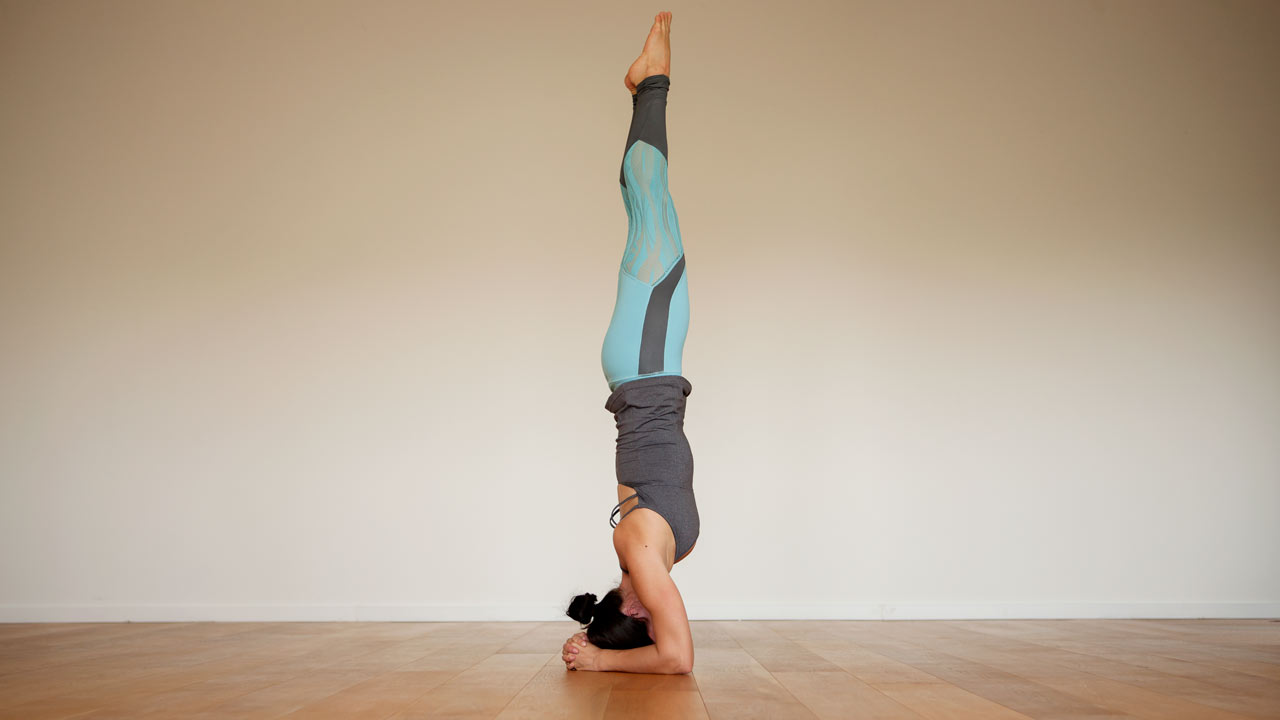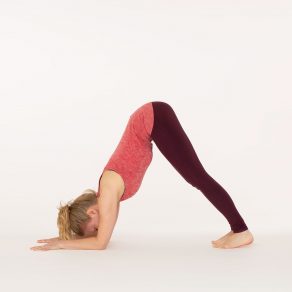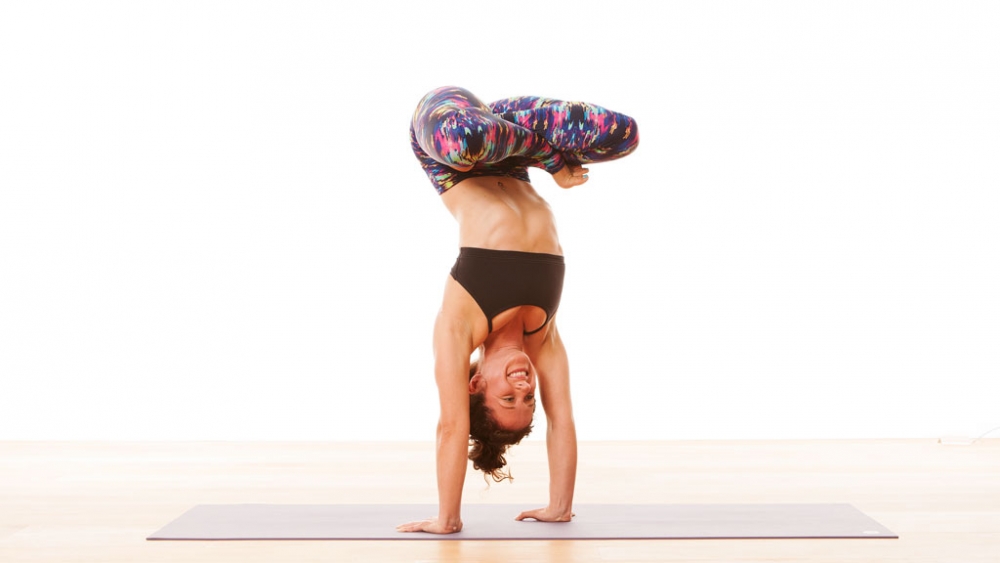For many people, the thought of inversions can trigger a fearful response! It’s not surprising; for most people going upside down does not come naturally. The road to a perfectly balanced Headstand is usually paved with a few falls along the way!
But inversions don’t have to be panic-inducing. While we might think of Headstands and complicated arm balances there are lots of ways to get the benefits of inversions without being a circus artist!
Inversions are yoga poses where the heart is higher from the ground than the head. So this includes poses like Supported Shoulder Stand with a folded blanket under the shoulders, Legs up the Wall pose and even Downward Facing Dog and standing forward bends
Let us explore some of the benefits of being upside down.
Physical Benefits
Strengthens

Inversions like Shoulderstand, Headstand, Handstand and Forearm Balance strengthen the arms, legs, back and core abdominal muscles.
They teach us the principle of “drawing into the mid-line” – this can be really helpful for improving our standing postures including balances like Hand to Big Toe Pose (Uttitha Hasta Padangustasana).
Circulation
Going against gravity helps venous return (the de-oxygenated blood going through your veins back to the heart). Venous return relies on muscular movement and gravity to move the blood. Inversions (and aerobics) give it a helping hand, improving circulation. At the same time you are also helping the flow of oxygenated blood to the brain, sensory organs and the face. We won’t make grand claims that they will banish your wrinkles and grey hair as some do!
Lymph flow
We can think of the lymphatic system as the sewage system of the body. Lymph picks up toxins, excess proteins and bacteria and carries them to the lymph nodes to be eliminated. Like with venous return, our bodies rely on gravity and muscular action to move the lymph so inversions can help us to flush the system.

“Putting your feet up” helps with swollen ankles and feet and tired legs. Take this further in a restorative Legs up the wall pose, I like to use props such as a folded blanket under my hips, a strap around the legs and a weight on my feet (I use a sandbag but you could easily use something else. Just make sure it’s something that won’t fall off onto you).
Nervous system
Inversions also have an effect on the nervous system. Headstand and Handstand are energizing: stimulating the nervous system and creating heat in the body. For this reason they are often followed by Shoulderstand or Legs up the wall pose which are more cooling and relaxing for the nervous system. These last two poses are great if you are suffering from too much stress or have insomnia.
Psychological benefits
Working up towards something like an arm balance requires humility and perseverance. We learn to fall out of a pose and to get back up again. Try not to be too hard on yourself, laugh and have fun in the process!
Inversions are great confidence boosters. Every time you become a little stronger or you get to the next phase, these poses have the ability to remind you of your greatness. Remember the benefits are there for you no matter what stage you are at.
Once you “make it” upside down, inversions are great confidence boosters. Every time you become a little stronger or you get to the next phase, these poses have the ability to remind you of your greatness :-). Remember the benefits are there for you no matter what stage you are at.
- Helping the flow of blood and oxygen to your brain helps with concentration and memory.
- Being upside-down changes your view on the world, both literally and metaphorically. It can teach us to get out of our habits and take a break from the norm.
- Inversions give us energy!
Some fundamental principles
A word of caution
While inversions bring all these benefits, substitute them for another pose if you have neck or head injuries, high blood pressure or eye problems like glaucoma. Listen to your body, sometimes it might be ok to do another kind of inversion while for some people Child’s Pose, Reclined Butterfly pose (Supta Baddha Konasana) or Savasana could be used.
Practise Ahimsa
If you don’t have any of these specific injuries you should still check in with how you are feeling today. Will an inversion help restore your tired energy, or will it potentially fragment your energy more? Is it a day to do some Yin instead? While you practice inversions it’s a good idea to keep in mind the first of the Yamas – Ahimsa (non-violence, compassion).
Practice…
Practice regularly and build up slowly and with integrity, hold poses like Headstand for a few breaths initially and build it up each day. Come into a Child’s Pose or a calming Forward Bend after strong inversions.
Strengthen and open
Strengthen what needs to be strengthened, open what needs to be open. Your inversion practice should include building a strong core – shoulders and neck muscles should be open, strong but not clenched, make sure they are warmed up well.
Menstruation
You can read a lot of conflicting ideas about whether it’s ok to invert while you are menstruating. There isn’t a definitive answer but the general consensus is that they should be avoided because it goes against what the body needs to do (the downward flow) – releasing blood and endometrial lining. Make it a personal choice. If you decide not to do inversions you can still work on them by doing gentle core work, balances and shoulder- opening poses.
Pregnancy
It all depends on your pre-pregnancy practice. If you practiced inversions comfortably before becoming pregnant, it could be beneficial to continue the poses through pregnancy, but only if it feels good! However please remember that during pregnancy is not the time to experiment with inversions (or any other difficult poses) that are challenging for you. If you did not practice inversions before pregnancy, it’s not wise to learn inversions during pregnancy. As with all yoga poses during pregnancy, let your intuition be your guide. If it feels good, do it. If it doesn’t, stop.
Safety
What goes up must come down. Make sure you are not going to fall on anything. When (if) you fall try to roll rather than tense your body. You can try inversions in the corner of a room so that you have support on both sides of you or try them with a friend.
Internal focus
Inversions can be the time we can fall into comparing ourselves with others in a class – it’s obvious who is up in a Headstand, who is taking their mat to the wall and who is working on preparatory poses. Try to keep an internal focus, practice with awareness and compassion for your own body and mind. 99.9% of people didn’t get straight up into a Forearm Balance without falling over lots of times first – watch our bloopers video if you don’t believe it!
Yoga inversion tutorials
Take a look at some of our tutorials and classes, taking you through inversions from beginner to advanced:
- Handstand how-to with Tashi Dawa
- Headstand tutorial with wall with Katy Appleton
- Inversion immersion: an upside down practice with David Lurey
- Upside down morning yoga with Adela Serrano
General inversion practices
- From Dolphin pose to Pincha Mayurasana with Esther (short)
- 20 min practice building up to Handstand and Forearm balance with Esther
- From Headstand to Forearm balance with Andrew
- Classical (Iyengar) shoulderstand sequence with David Lurey

